EXPLORE: The Sun
| Site: | Mountain Heights Academy OER |
| Course: | Earth Science Q1 |
| Book: | EXPLORE: The Sun |
| Printed by: | Guest user |
| Date: | Saturday, 26 July 2025, 2:12 PM |
Description
This book will describe the stages our sun will pass through in its life cycle.
1. Life as a Protostar
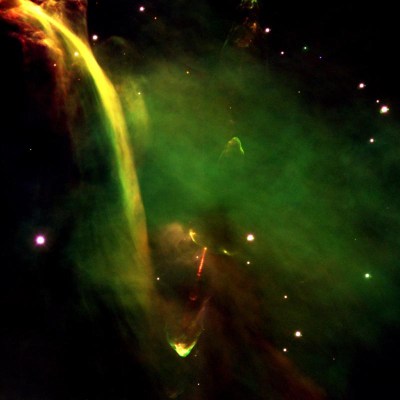
Herzig-Haro 34; a protostar. Photo courtesy of
Now that you know the life cycle of stars in general, we will now compare it to our sun. Before nuclear fusion, when the sun was still being created in the interstellar nebula, it was just a protostar. A protostar forms when gravity and pressure begin to condense matter in the center of the nebula, but no nuclear fusion is yet taking place. When nuclear fusion begins, a star is "born". Our sun started burning hydrogen at 4.5 billion years ago. When the sun started it was a little smaller, less bright and cooler than it is today. The sun has enough hydrogen to burn steadily for 11 billion.
This chart shows the life cycle of our sun:

Chart courtesy of Tabilzer/Wikimedia.
The text has been adapted for a 9th grade level. This was originally the hypertext version of a public lecture given on 1997 June 12 at the Perkins Observatory in Delaware, Ohio, as part of the 1997 New Vistas inAstronomy lecture series. It has been updated a number of times since then.The Once and Future Sun by Richard W. Pogge is licensed under a Creative Commons Attribution-Noncommercial-Share Alike 3.0 United States License. Based on a work at The Ohio State University Department of Astronomy (www.astronomy.ohio-state.edu)
2. Main Sequence
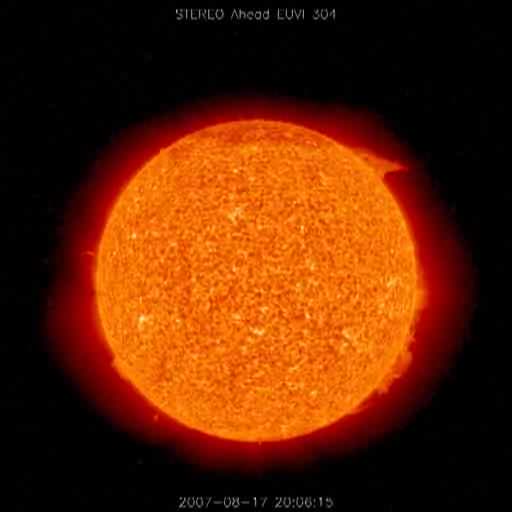
The sun is in the middle of its lifespan, and is currently in the main sequence phase. At this stage in its life the sun is fusing hydrogen into helium. As the Sun becomes older, it grows slightly larger, brighter and hotter. At about 1.1 billion years from now the Sun will be 10% bigger than it is now. As a result, the extra solar energy will dry up Earth's atmosphere and many kinds of life. In about 3.5 billion years, the sun will be 40% bigger and will probably mean that all life on Earth will cease to exist. The next stage will be for the sun to become a Red Giant.
Sources: The text has been adapted for a 9th grade level. This was originally the hypertext version of a public lecture given on 1997 June 12 at the Perkins Observatory in Delaware, Ohio, as part of the 1997 New Vistas inAstronomy lecture series. It has been updated a number of times since then.The Once and Future Sun by Richard W. Pogge is licensed under a Creative Commons Attribution-Noncommercial-Share Alike 3.0 United States License. Based on a work at The Ohio State University Department of Astronomy (www.astronomy.ohio-state.edu)
3. Red Giant
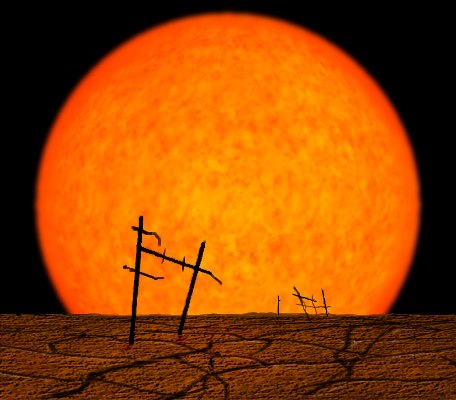
When the sun is 12.2 billion years old it will enter the Red Giant phase. At this point, the outer layers of the sun will expand, but its core will contract. The sun will become big enough to completely consume the planet Mercury. As a red giant, the sun will be cooler in temperature, but brighter. When the Sun reaches its maximum size as a red giant, helium fusion will occur in the core, and the star will begin to release more energy. As a result, the sun will shrink in size, but become hotter. The carbon within the sun begins to collapse inward, as helium begins to fuse into carbon. Elements heavier than carbon typically do not fuse inside small-mass stars. In order for nuclear fusion of heavier elements to take place, the sun would have to be about four times bigger than it is. Once the Sun is 12.3 billion years old, it will run out of helium. Since the sun doesn't have any more fuel to burn, this stage marks the beginning of the end.
4. Planetary Nebula
As the sun nears the end of its Red Giant phase, most of its outer layers (which contain the lightest elements) will be vented off into space. This forms a planetary nebula. The lighter elements from the sun are forcefully vented into space, but this should not be confused with a supernova that happens to more massive stars. This is the shortest phase of the sun's life cycle. The result is that the sun loses mass at a high rate and becomes cooler in temperature, but very bright. Eventually, all that will be left of our star is its dense core.
5. White/Black Dwarf
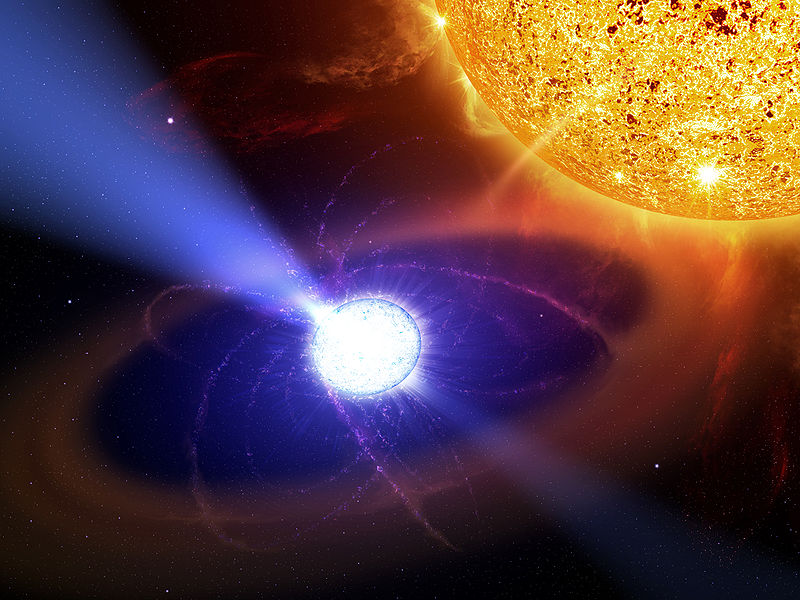
By the end of its planetary nebula phase, the sun will have lost most of its mass, and only its dense core will remain. At this point, the sun will become a white dwarf. A white dwarf is very dense because it contains only the heaviest elements fused over its lifetime, but no more nuclear fusion will be taking place. Because there is no more nuclear fusion occurring in its core, the sun will become much cooler in temperature and only give off a fraction of the light it once did. Over time the Sun will stop generating any heat or light. When no more nuclear fusion is taking place, the Sun will end its life as a black dwarf. Scientists aren't sure what this will look like because the process can take trillions of years, and our universe is only 13.7 billion years old.
The following video is a little long, but it does a great job explaining what is happening during these stages of the sun's life.
Sources
The text has been adapted for a 9th grade level. This was originally the hypertext version of a public lecture given on 1997 June 12 at the Perkins Observatory in Delaware, Ohio, as part of the 1997 New Vistas inAstronomy lecture series. It has been updated a number of times since then.The Once and Future Sun by Richard W. Pogge is licensed under a Creative Commons Attribution-Noncommercial-Share Alike 3.0 United States License. Based on a work at The Ohio State University Department of Astronomy (www.astronomy.ohio-state.edu)
6. The Layers of the Sun

The halo of gas around the sun is called the corona, the outermost layer of the sun. Photo courtesy of Wikimedia.
The Sun is composed of three layers. The layer we can see with the naked eye here on Earth is the photosphere which is the only visible layer of the Sun. Most of the visible light from the sun comes from this layer. Hot spots and solar flares also are located in this layer. Beyond that is the chromosphere, which is hotter than the photosphere. The chromosphere is usually only visible during a solar eclipse.The corona is the hottest and outermost layer of the atmosphere. It consists of low-density gas with a temperature greater than one million degrees Kelvin (1 million Kelvin is equal to 999,727 degrees Celsius). Solar winds escape through holes in the corona.
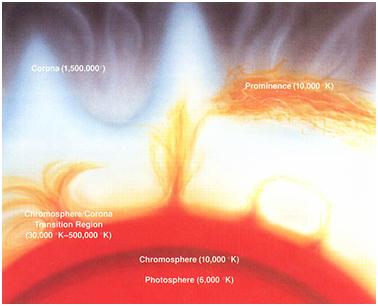
Layers of the sun. Image courtesy of TeachEngineering.
Source: TeachEngineering. Our Amazing, Powerful Sun. Retrieved from http://www.oercommons.org/courses/our-amazing-powerful-sun/view on August 23, 2012.